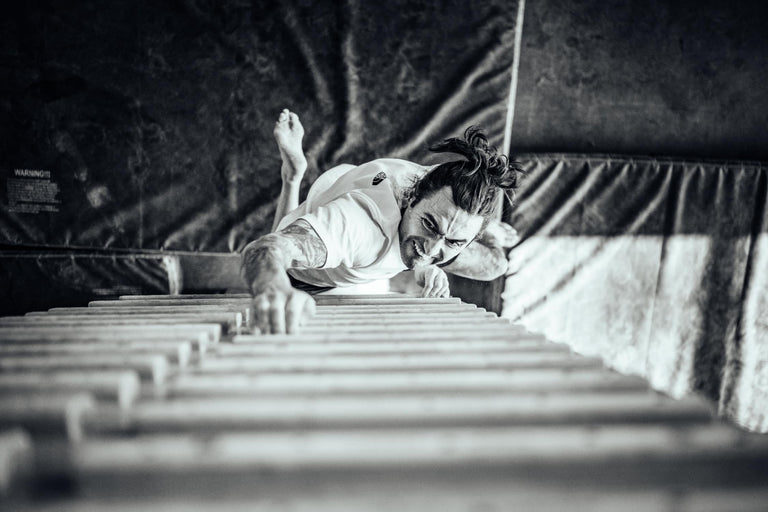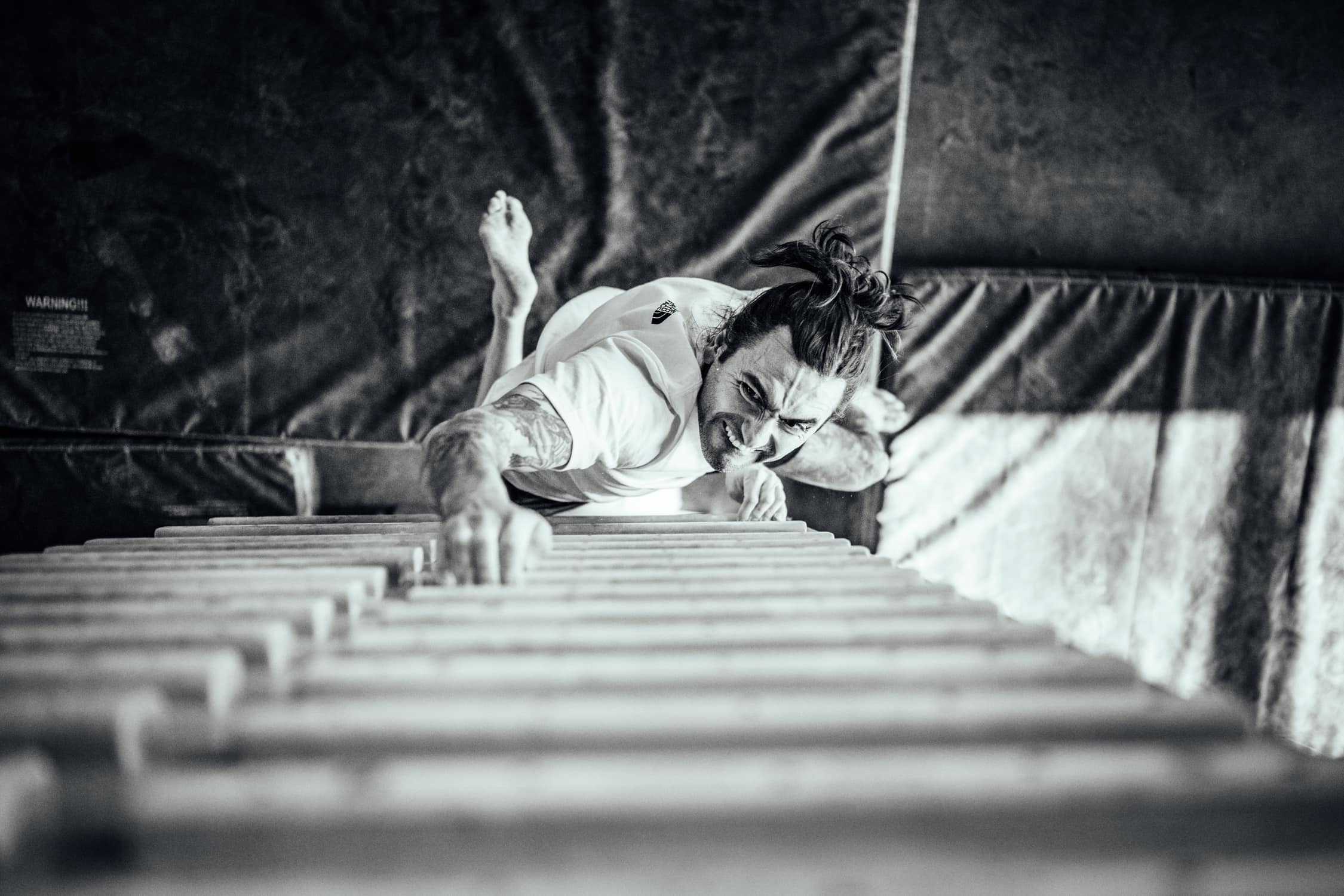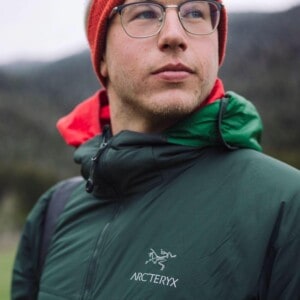Sam Elias was born and raised around Detroit. His father immigrated from Syria, and his mother is Polish-American. Sam is a skilled all-around mountain athlete. He has skied since the age of 2 and raced competitively from adolescence through college on a scholarship. Since starting climbing after college in 2005, he has climbed Everest, Yosemite big walls and hard, technical trad, sport and ice climbs, and won the Ouray Ice Climbing comp in 2019.
Sam’s accomplishments and interests range further tha moving over rock or ice; having an artistic and creative background, and needing balance points to athletic expression. He studied art in high school and has a ceramics degree from college (as well as a biology degree), he practices block printmaking, he has designed some of his own tattoos, and also a couple lines of clothing for The North Face as well as the Find Your Pack t-shirt for Gnarly Nutrition.
“Fuel for Life: Sam Elias,” a film by Mike Call, features a modified version of Sam’s poem, “Kindling,” and explores the idea spectrum of fuel in various forms, extending into the abstract beyond just food or liquid energy.
We went behind the scenes with Sam and Mike to talk about the filmmaking process and to dig deeper into “Kindling.”

Can you each describe your relationship with each other? Why were you most comfortable working together on this project?
Mike:
Sam and I have done projects together for years, and we’re close friends. He has been around my creative process for what feels like forever, and sees how I do my work. In everything I do, I try to create an emotional, real film, not so much branded content, even if the piece is coming from a brand. I try to find a truth behind what the words are, which pairs really well with who Sam is as a person. He’s introspective, and he isn’t going to say empty words. He’s going to say what he really believes in.
Sam:
Gnarly asked for a fairly personal and emotional piece. I’ve known Mike for a really long time … maybe 15 years? A deep connection between a filmmaker and an athlete translates through a finished product. There is no way to get to the core of someone without trust. When it sounded like these films were meant to be highly personal, there was no way I could work with someone I didn’t know well and trusted deeply.
Sam, this film features your written words, “Kindling.” Can you tell us about the process of writing this and how you and Mike decided this to be the film’s narrative?
I basically wrote a poem, and then we translated it into a monologue. Reading a poem in the course of a film doesn’t always work so well, so we had to make tweaks here and there to make the words flow and sound more conversational, rather than rigid. Mike and I spent several sessions going through it.

Mike, you could have filmed this video in any style: interview, all voice-over, and so on. How did you determine this approach?
A ‘talking head’ adds breaking points to a film. With this piece, I wanted to put the viewer into Sam’s world completely. I didn’t want to make it feel like they were being spoken to; I wanted to put people in Sam’s head and to hear what he’s thinking. It doesn’t have to be exactly literal, but more thought-provoking. There’s a lot of wisdom in “Kindling,” so it was important for people to really hear those words.
Tell us about the visuals flipping between black-and-white, and color.
Mike:
The intensity of the black-and-white reflects the serious nature of working at something, like training in a gym, while the scenes in Sam’s house are warm, inviting, relaxing and soothing, which reflects also in the paints he works with and the food he makes.
Sam:
I think the black-and-white helps punctuate the effort of training, and helps amplify the reasons for training in the first place. In a way, it’s a nod to the simplification and minimalism, and how reducing complexity makes the process of action and effort less confusing.
Sam, in “Kindling,” you say that fuel can be things that are “immaterial, like information, idea, opinion, emotion, socialization, conditioning, trauma, rest and stillness.” Can you expand on this? Are there any of these immaterial fuels that have fueled you in any way recently?
Things like sadness, anger, unfairness in the world in the form of social inequity … those things, for better or for worse, get integrated into me personally. There’s a lot of motivation that I derive from these emotions and conditions. A lot of what happened in 2020, like the murder of George Floyd, the election cycle and subsequent civil unrest, definitely affected how I train in the gym and the way that I perform.
Training is partially an escape from all of that, but sometimes it can be a fuel to train harder, and sometimes it makes things like climbing difficult to do in the first place.
But we don’t have to be victims to the negativity of the world, and I hope this film helps show people that hardships can be used as fuel to better yourself, your immediate community, or even broader circles, all the way up to the global level.
This film shows you creating art and there is a clip that shows prints you have made hanging on your wall. Does that artistic process help you digest and translate those immaterial fuels into something tangible?
Yea, all of that helps me make a statement without having to use words. The creative process renders something that I think is beautiful, in terms of an image, that can then also be functional and useful, like a t-shirt.
Something that we at Gnarly took away from the film was the contrast of states of being, and the act of finding balance in life. Sam, how do you manage balance in your daily life?
I think ‘balance’ is a myth. Life is sloppy and messy. We get better at finding the middle over time, but it’s always hard.
Balance isn’t two-dimensional, like a line. It’s more like a three-dimensional sphere. It’s about bringing the extremes of any two opposites closer together. This can be emotions, like happiness against sadness; it can be work against play; it can be training against rest; it can be creativity against monotony … for any thing, there is an opposite.
That’s what balance is: It’s about understanding the opposites of things, and understanding the tensions between two opposites, and working to bring both of them closer together.
Watch the full film!






